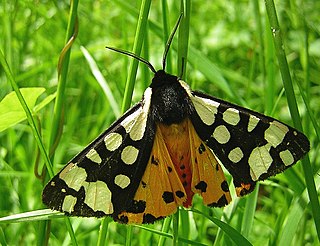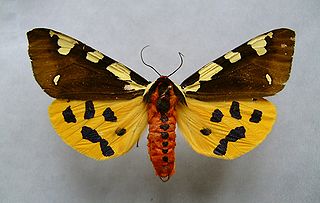
The Arctiinae are a large and diverse subfamily of moths with around 11,000 species found all over the world, including 6,000 neotropical species. This subfamily includes the groups commonly known as tiger moths, which usually have bright colours, footmen, which are usually much drabber, lichen moths, and wasp moths. Many species have "hairy" caterpillars that are popularly known as woolly bears or woolly worms. The scientific name Arctiinae refers to this hairiness. Some species within the Arctiinae have the word "tussock"' in their common names because they have been misidentified as members of the Lymantriinae subfamily based on the characteristics of the larvae.

The Arctiina are a subtribe of moths in the family Erebidae.

Arctia is a genus of tiger moths in the family Erebidae. Therein, it belongs to the subtribe Arctiina in the tribe Arctiini in the subfamily Arctiinae. Species are well distributed throughout North America, Palearctic, India, and Sri Lanka.

Chelis is a genus of tiger moths in the family Erebidae. There are more than 30 described species in Chelis, found in the holarctic.

Arctia villica, the cream-spot tiger, is a moth of the family Erebidae. The species was first described by Carl Linnaeus in his 1758 10th edition of Systema Naturae. It is distributed from the Iberian Peninsula, Anatolia, western and northern Iran, western Siberia, southwestern Asia and North Africa.

Arctia matronula is species of tiger moth in the family Erebidae. It was first described by Carl Linnaeus in his 1758 10th edition of Systema Naturae. It can be found in central and eastern Europe, Kazakhstan, southern Siberia, northern Mongolia, Amur Region, Primorye, Sakhalin, Kunashir, northern and northeastern China, Korea and Japan.

Arctia virginalis, the Ranchman's tiger moth, is a species of tiger moth in the family Erebidae. It was first described by Jean Baptiste Boisduval in 1852.

Arctia aulica, the brown tiger moth, is a moth of the family Erebidae. The species was first described by Carl Linnaeus in his 1758 10th edition of Systema Naturae.
Arctia thibetica is a species of tiger moth in the family Erebidae, found in the northwestern Himalayas of India.

Arctia testudinaria, or Patton's tiger, is a moth of the family Erebidae. It was described by Geoffroy in 1785. It is found from northern Spain to southern and central France and southern Switzerland to north-eastern and southern Italy. It has also been recorded from Great Britain. The habitat consists of grasslands, slopes, forest edges, clear dry forests, cliffs and mountain slopes, maquis, garrigues and dry meadows.
Arctia bundeli is a moth of the family Erebidae. It was described by Vladimir Viktorovitch Dubatolov and Vladimir O. Gurko in 2004. It is found in Tajikistan.
Arctia gurkoi is a moth of the family Erebidae. It was described by Vladimir Viktorovitch Dubatolov in 2004. It is found in Pakistan and possibly Xinjiang, China.
Arctia ornata is a moth in the family Erebidae. It was described by Otto Staudinger in 1896. It is found in the Russian Far East and Mongolia.
Arctia murzini is a moth in the family Erebidae. It was described by Vladimir Viktorovitch Dubatolov in 2005. It is found in Shaanxi, China.
Arctia allardi is a moth in the family Erebidae. It was described by Charles Oberthür in 1911. It is found in China.
Arctia kasnakovi is a moth in the family Erebidae. It was described by Vladimir Viktorovitch Dubatolov in 1987. It is found in Qinghai, China.
Chelis golbecki is a moth in the family Erebidae. It was described by Vladimir Viktorovitch Dubatolov in 1996. It is found in the Kyrgyz Ala-Too Range of Central Asia.
Chelis gracilis is a moth in the family Erebidae. It was described by Vladimir Viktorovitch Dubatolov in 1996. It is found in the Chatkal Mountains and Kyrgyzstan.

Chelis gratiosa is a moth in the family Erebidae. It was described by Grigory Grum-Grshimailo in 1890. It is found in the western Tien Shan, the Pamir-Alay, Kyrgyzstan, Turkestan, Hissar, Trans-Alai, the Pamir Mountains, Pakistan, Kashmir and western China.
Chelis mira is a moth in the family Erebidae. It was described by Vladimir Viktorovitch Dubatolov and Yuri A. Tshistjakov in 1989. It is found in the south-eastern Altai Mountains.











